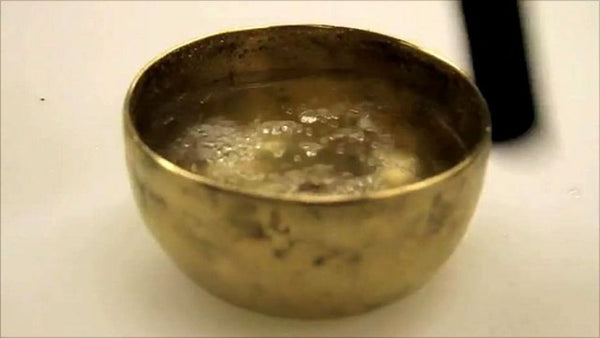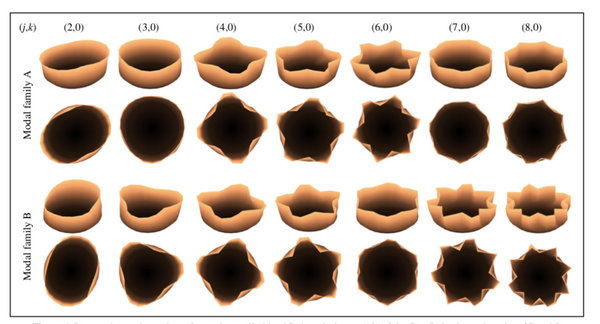Have you ever wondered how singing bowls work? In this post, we answer that question by discussing the science of singing bowls. Read on to learn how these incredible creations produced their incredible sounds. We also explain how singing bowls can be used with water to change their sounds as well as discuss the physical effects of playing singing bowls.
Introduction
While the enthralling sounds of singing bowls might calm you, they might also spark the question, “how exactly do they work?” Like all musical instruments, Tibetan singing bowls rely on friction and vibration to create the sound we hear. What makes singing bowls so special are the different sounds that can be created by them depending on their qualities and the various circumstances and conditions in which they may be played.
Scientists and musicians alike have recently become interested in the singing bowl and the manner in which it creates sound. The science behind the sounds of singing bowls is quite simple and can best be compared to playing wine glasses filled with water. However, the science behind the healing properties of singing bowls is not quite as familiar or established.
In this article we discuss:
- How do singing bowls work?
- How can singing bowls be used with water?
- What are the physical effects of singing bowls?
How Do Singing Bowls Work?
To play a singing bowl, one must either strike the bowl or rub the rim with a mallet. The action taken with the mallet is the first step in creating sound with a singing bowl. As explained by Science Made Simple UK, the friction created either by rubbing or striking a singing bowl creates vibrations. These vibrations create the sound we hear and can feel when holding the singing bowl. As you continue to rub the rim of the bowl, the friction keeps the sound going. This is called resonance. Resonance is the note we hear even after the player ceases contact between the singing bowl and the mallet.
To make matters a bit more complicated, the note we hear can differ between singing bowls and mallets. Most singing bowls are made from a bronze alloy of either copper, tin, zinc, iron, silver, gold, or nickel. The material with which the singing bowl is made can change the sound, as can the mallet. Crystal bowls will not sound the same as bronze alloy bowls. Wooden mallets and padded mallets will produce different sounds as well. The size, shape and weight of the singing bowl can also affect what tones are produced. Adding water will change the note of the singing bowl as water is more difficult to vibrate than the air inside an empty singing bowl. Cushions, rings, or other accessories also alter the sound of singing bowls, often dampening or softening the sounds. Despite these differences, how singing bowls work can be boiled down to a simple idea: excitation of the rim causes the singing bowl to vibrate, creating a rich tone.
Singing Bowls and Water

Source: BBC
Many of the studies revealing the inner workings of singing bowls focus on singing bowls filled with water. In particular, there are multiple studies devoted to observing the way water is excited when playing a singing bowl. Two studies, one done by Octávio Inácio et al. called “The Dynamics of Tibetan Singing Bowls,” and another by Denis Terwage and John Bush called “Tibetan Singing Bowls,” have studied just that. These groups observed singing bowls filled with water being played with slow motion video and sound recording. In turn, their studies were summarized in a BBC article by Jason Palmer.
They found that as the singing bowl is played, the rim begins to change shape, switching back and forth between slightly oval shapes. The energy of the bowl transfers to the water. The energy charged water creates waves, which create droplets of water that bounce and skip on the surface. This phenomenon is known as Faraday waves. These studies have much larger implications than just acoustic music or sound meditation and healing--the study of the singing bowl’s Faraday waves can actually be applied to processes such as fuel injection.

A figure from the study, “The Dynamics of Tibetan Singing Bowls”, showing the different shapes of singing bowls when being played.
Adding water changes the frequency of the singing bowl. The addition of water often lowers and creates a deeper, longer-lasting resonance. Incorporating water filled singing bowls can create additional tones used for meditation or sound therapy, but it can also be an example of an interesting science experiment. How singing bowls work is based on scientific studies and physics. On the other hand, the effects of singing bowls on our bodies and well-being is on less solid scientific ground but should be discussed nonetheless.
What are the Physical Effects of Singing Bowls?
Researching the scientific physical effects of singing bowls has yielded lots of contradictory evidence. Overall, most publications focus on the beneficial side effects of using a singing bowl in sound therapy rather than scientific proven fact that singing bowls can heal a variety of ailments. In fact, Chris Kyriakakis, a professor of audio signal processing at the University of Southern California’s Viterbi School of Engineering has said that there are no “scientific published peer reviewed papers” that support the claims that sound therapy “unblocks or redirects energy in the body” or that the vibrations produced work in tandem with humans’ own vibrational frequencies.
Despite Professor Kyriakakis’s statements, positive testimonials from other professionals and practitioners is overwhelming. One of the biggest proponents of using singing bowls for healing was Mitchell Gaynor, an oncologist and professor at Weill Cornell Medical College. Gaynor, who began working with singing bowls in the 1990s, championed the use of sound healing in addition to conventional treatment and medicine. The reason for this, Gaynor argued, was that sound therapy eased the psychological and physical effects of those with disease. He also argued that sound therapy gave patients “lower stress hormones and stronger immune systems.” The pulsating tones of the singing bowl help practitioners feel good and relax.
Practitioners will also sometimes provide the afflicted with sound therapy as an alternative treatment for problems such as anxiety, chronic pain, sleep disorders, and PTSD. These practitioners maintain that sound therapy places listeners in a meditative state, in turn, allowing them to de-stress, relax, and heal.
There are numerous articles on the internet written by sound healers and those that incorporate singing bowls into their treatment for a variety of illnesses and disorders. Singing bowl vibrations can have various physical, emotional, and spiritual effects on the mind and body. Sound therapy can be a great additional or alternative treatment to a number of physical or mental problems or just added relaxation to meditation or yoga classes.

The Bottom Line
We now know that singing bowls sing not because of magic or mystical forces. Singing bowls sing because of physics! Vibrations and resonance are created by striking the bowl with a mallet. In addition, while the scientific evidence is not clear, a wealth of anecdotal evidence indicates that singing bowl tones have positive physical, mental, and emotional effects on those who hear them. Tibetan singing bowls have been used in religious practice for about 2500 years and are now increasingly found in sound therapy practices, meditation, and yoga classes. Singing bowls work like any other instrument but their implications to improve our lives are endless!
We invite you to get your own Tibetan singing bowl or crystal singing bowl today!
Did You Enjoy This Article?
Thank you for reading! If you enjoyed this article, you might also like the following articles: Singing Bowl Tones and Frequencies: Complete Guide and Crystal Singing Bowls: The Complete Guide


11 comments
Jul 04, 2023 • Posted by Shanti Bowl
Hi Yonton, thanks for your question! It is a great idea to start your collection slowly and thoughtfully. If you are looking to get started with an authentic crystal signing bowl, then we suggest that you buy one of our bowls – click the “Shop” button at the top of our website to see our collection! Please let us know if you have any questions!
Jul 04, 2023 • Posted by Yonten
Dear Shanti I love to own crystal bowls but I do not know their authenticity and do i have to buy a set or slowly add on. Would you be able to guide me. Thank you.
Nov 21, 2022 • Posted by Kevin Jackson
I just had my first experience with a Crystal singing bowl. This amazing sensation went through my body. I tried to explain it to my wife, but she thinks I’m a wee bit nuts talking about it. There was 100% a positive mental response and in turn a physical response. Life just felt right afterwards. Stress and anxiety just seemed to melt away instantly and a calmness flowed through my body (that I could literally feel). Amazing experience that I will be exploring further.
Aug 20, 2021 • Posted by Shanti Bowl
Hi Linda, thanks for your comment! So glad to hear that you enjoyed our article!
Aug 20, 2021 • Posted by Linda Eisenstein
Great Article- Thanks for all the great info and I especially liked the reference to the Beach Boys song- Good Vibrations! “I’m picking up good vibrations… She’s giving me exitations!!” Be a great song for you to use.
Jun 09, 2020 • Posted by Shanti Bowl
Hi Brooke, thanks for your interesting question! We had not heard that about the San Francisco bridge – how lovely! In terms of finding a singing bowl that sounds the same, you would need to start by figuring out the tone and frequency of the sound made by the bridge. We have a great blog post on that subject here: https://www.shantibowl.com/blogs/blog/singing-bowl-tones-and-frequencies-complete-guide. Once you have determined that, you can search for a bowl with a comparable tone and frequency. We hope that helps! :)
Jun 09, 2020 • Posted by Brooke
I just saw video of the Golden Gate Bridge in SF that now is the largest wind instrument in the world due to engineering design of new rails recently installed. Videos on YT and Twitter. I love it, sounds soothing. Is there a way to find a specific bowl to purchase that has this same tone? It is good to think it may bring calm to an entire city in such difficult times, can be heard up to three miles away. I hope it is not a hoax because it sounds amazing and I hope to hear it in person some day.
Apr 26, 2020 • Posted by Shanti Bowl
Hi Omega, thanks very much for your question! That sounds very interesting. From a physics perspective, one possible explanation is that by striking the singing bowl you created a depression in one part of the bowl which inhibits the creation of resonance when the mallet is rubbed along the rim of the bowl. If this occurred, then you may be able to hammer the bowl back into proper shape, although this will take some trial and error. Give that a try and let us know if it works!
Apr 26, 2020 • Posted by Omega Theta
I recently used a very special singing bowl of mine to connect and resonate with the entire cosmos. Afterward I accidentally struck the bowl softly with anger in my consciousness and the bowl fell out of its higher energy (?) resonant state with an thud and now does not sing. Physicists?
Others? Thank you! <3
Onegatheta999@icloud.com
Mar 10, 2020 • Posted by Shanti Bowl
Hi Lillian, thanks for your question! Yes, there should be a way to determine the pitch an object will make when played before actually playing it; after all, singing bowls are often made with a particular pitch in mind. Doing so involves some significant calculations which are informed by a number of factors, including the size, type and thickness of the material from which the instrument is made. We hope that helps!
Leave a comment